The following work is a series of discussion questions meant to provoke thought about images of Brazilian history found in the John Carter Brown Archive of Early American Images. There are twenty images that depict a wide array of subjects and an additional ten images created by the French artist Debret. The questions that accompany each image are meant to engage the viewer with the work to relate the image to his or her knowledge of Brazilian history. As such, we believe that the student can gain a more nuanced understanding of Brazilian history through exploring information of multiple mediums as this method requires a complex synthesis of varied facets of Brazilian history and culture. Accordingly, these questions and images are wholly relevant to our project’s larger mission of producing a coherent, pedagogical work on the history of Brazil for students of Brazilian history. The questions were created with reference to class lectures and also formed with regards to the information in Thomas Skidmore’s text, Brazil: Five Centuries of Change.
 | “How we arrived at America, were unable to make out the harbor, and how a great storm came upon us” - 1593 ©John Carter Brown Library, Archive of Early American Images ID: 2930004 In what ways are the native Indians depicted differently from the Germans? How is this illustration indicative of general European attitudes towards native peoples at this time? |
"... le bois du Bresil trouué, auec plusierus autres arbres non veuz ailleurs qu'en ce païs" - 1558 ©John Carter Brown Library, Archive of Early American Images ID: 6540005 The author of this image, Thevet, was a Franciscan monk who traveled to Brazil and stayed only ten weeks to write articles based on his observations. In this light, how was he trying to portray Brazil and its people and what message was he trying to convey to his audience? | 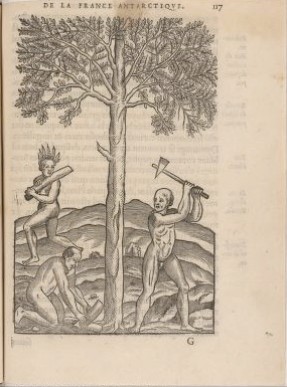 |
 | "The Rio Exchange, a Public Trapiche, a Grass Wagon and the Gallows" - 1821 ©John Carter Brown Library, Archive of Early American Images ID: 8390007 How does the Rio Exchange building reflect ‘old world’ European architectural styles and how does it illustrate new Brazilian ones? Why was the building designed this way? |
"Tinturaria Indigo" - 1806 ©John Carter Brown Library, Archive of Early American Images ID: 8130007 This is an image of the Portuguese Royal coat of arms surrounded by indigo flowers, leaves and a royal crown. How do these objects reflect Brazilian identity at the turn of the 19th century when this image was created? | 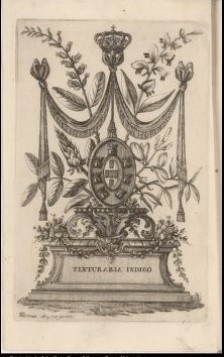 |

"…Das Norder theil des Lands Brasillien…" - 1634
©John Carter Brown Library, Archive of Early American Images ID: 3750003
This is a birds eye view of Olinda and Recife from 1634, produced during a Dutch expedition to Brazil. What elements are included in this map? Why are they significant? Does the map reflect a scientific approach to illustrating the land or a strategic one, perhaps for purposes of colonization?
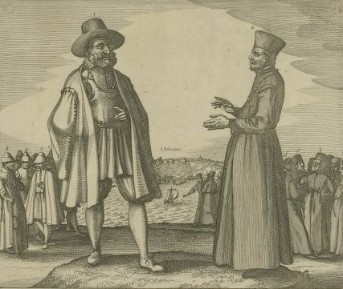 | "Steyger- Praetjen Tusschen Jan Batavier en Maetroos…" - 1624 ©John Carter Brown Library, Archive of Early American Images ID: 1100002 This is an image of a Jesuit standing before a group of clerics and soldiers in Salvador de Bahia. What role did the Jesuits play in the development of Colonial Brazil? |
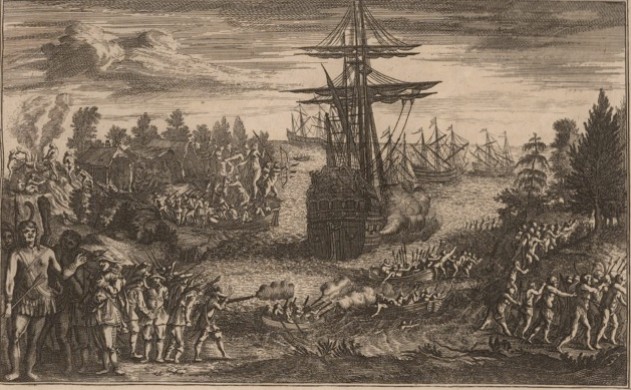
"Vespucci lands on Curaçao" - 1681
©John Carter Brown Library, Archive of Early American Images ID: 7020001
How does this image typify the Native peoples? How are the Europeans shown? In what ways are the Europeans portrayed as ‘superior’ to the Native Americans?
"Negroes washing for diamonds, gold, etc." - 1823 ©John Carter Brown Library, Archive of Early American Images ID: 5220009 This is an ink etching of slaves mining for diamonds in a river. How are race, gender, and social status illustrated in this image? How do the different roles of the figures vary based upon these stereotypes? | 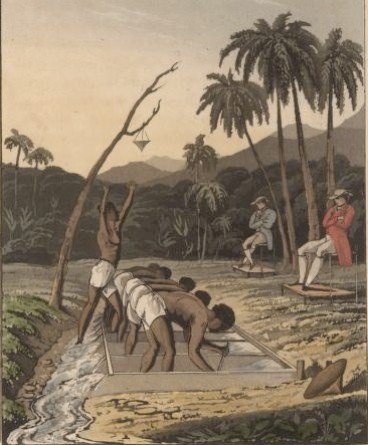 |
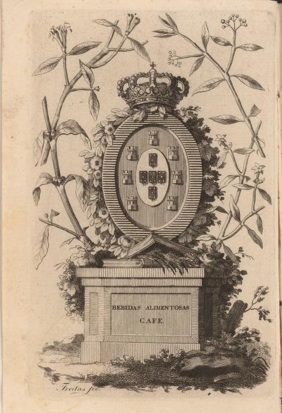 | "Portuguese Coat of Arms and Coffee Plants" - 1800 ©John Carter Brown Library, Archive of Early American Images ID: 8280004 This image shows the royal coat of arms surrounded by coffee plants, the crown, books, leaves, and flowers. How does this image relate to ‘Tinturaria Indigo’? What is the significance of the depicted objects? |

"Palace and Great Square in Rio de Janiero" - 1823
©John Carter Brown Library, Archive of Early American Images ID: 5220005
In light of the newly established Brazilian independence, how does this illustration show the new state? How does the Square’s architecture glorify Rio de Janiero? What kinds of activities are taking place in the square? How do these activities reflect the growing Brazilian identity?
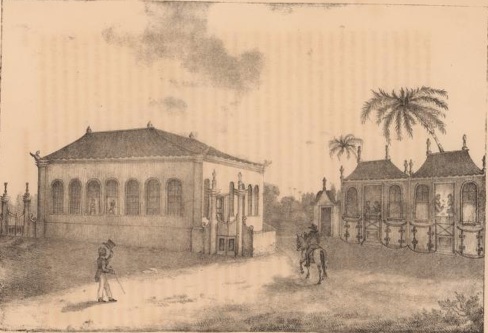
"Style of Houses at Poço de Penella" - 1821
©John Carter Brown Library, Archive of Early American Images ID: 8410001
This is a lithograph of homes in Poço de Penella in Pernambuco. Who likely lives in these homes? How are these houses similar to European ones? How are they different?
"Vue dans l’interieur de l’Ile de Ste. Catherine" - 1826 ©John Carter Brown Library, Archive of Early American Images ID: 4780004 This is an image of the Brazilian countryside created by a Frenchman on an exploratory expedition. How does this image differ those you have seen of urban areas? What parts of the landscape does the artist particularly emphasize? | 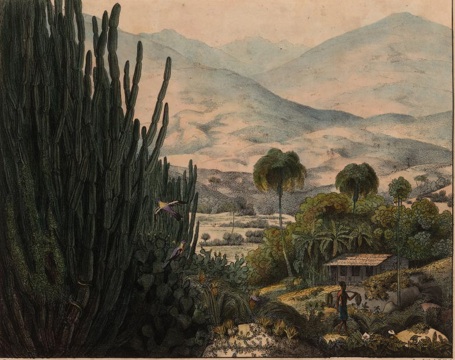 |

"View of St. Salvador, a City of South America" - 1785?
©John Carter Brown Library, Archive of Early American Images ID: 3450007
How is the city shown in this image? How does it relate to what you know about Brazilian urban planning and development? What are the advantages and disadvantages of this layout?
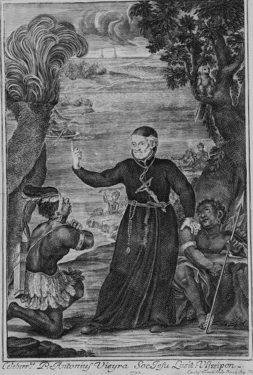 | "Celeberr.us P. Antonius Vieyra Soc. Jesu Lusit. Vijssipon" - 1742 ©John Carter Brown Library, Archive of Early American Images ID: 1060002 This image shows Antonio Vieira preaching to two kneeling Native Americans. What does this illustrate about the relationship between Native Americans and the Jesuits? How are the Natives pictured? How is the Jesuit shown? Do you think that this is an entirely accurate engraving or one altered for propagandistic purposes? |

"A Lady Going to Visit" - 1816
©John Carter Brown Library, Archive of Early American Images ID: 5230008
What does this image say about the Brazilian class structure? What does the clothing of the slaves convey about their owners?
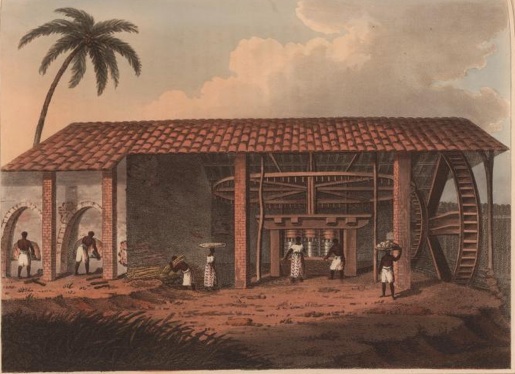
"A Sugar Mill" - 1816
©John Carter Brown Library, Archive of Early American Images ID: 5240008
What was the role of a slave in a sugar mill? How did the assignment of slaves to different tasks in engenhos reflect his position within the slave hierarchy?
"Wie sie des tages mit mir umbglengen…" - 1557? ©John Carter Brown Library, Archive of Early American Images ID: 220002 How does this image depict gender, age, race, and status? What does this say about European colonization initiatives in North America? | 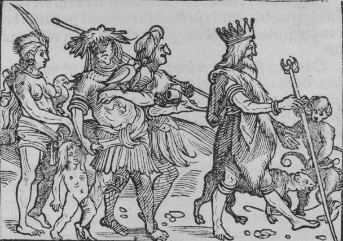 |
 | "Plants and Trees of Brazil" - 1704 ©John Carter Brown Library, Archive of Early American Images ID: 2400004 What plants and trees are shown in the image? Does it seem to be a scientific or propagandistic illustration of Brazilian wildlife? |
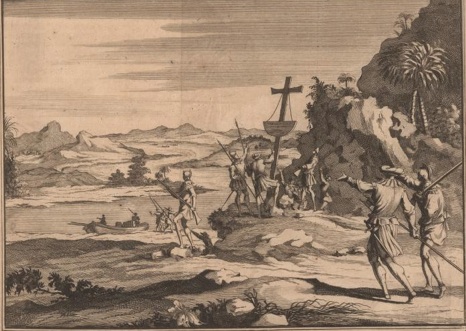
"Europeans view a cross on shore" - 1706
©John Carter Brown Library, Archive of Early American Images ID: 9070005
This image shows Europeans arriving near present day Ilha Santa Catarina and viewing a cross planted along the coast. What does this suggest about the importance of Christianity in the New World? How was religion used as a tool for Brazilian colonization?
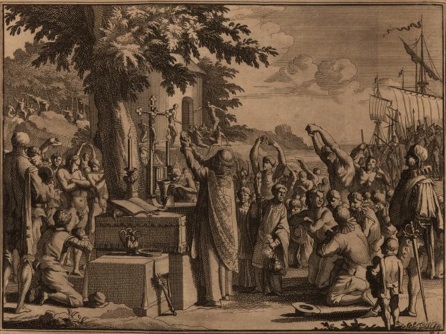
"Priest celebrates the Eucharist" - 1707
©John Carter Brown Library, Archive of Early American Images ID: 5050001
The people shown in this drawing all appear light skinned and fair-haired. Interestingly, some are supposed to be Native Americans. How can you tell which people are the Natives and which are the Europeans? Why do you think the artist illustrates the figures in this way?
"Chef Camacan Mongoyo" - 1834 ©John Carter Brown Library, Archive of Early American Images ID: 8730006 This is a portrait of a Native American chief. In what ways is this portrait an accurate illustration and in what ways is it false? What does his attire signify? | 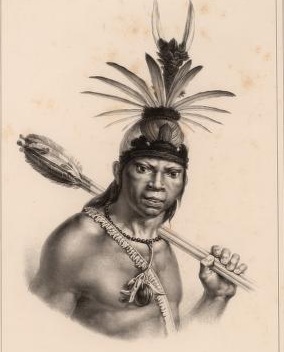 |
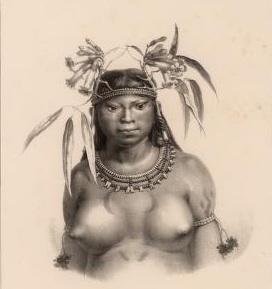 | "Femme Camacan Mongoyo" - 1834 ©John Carter Brown Library, Archive of Early American Images ID: 8730007 This portrait is the female counterpart to Debret’s 1834 image, ‘Chef Camacan Mongoyo’. In what ways were Native men shown differently from Native women? In which ways are they shown similarly? |
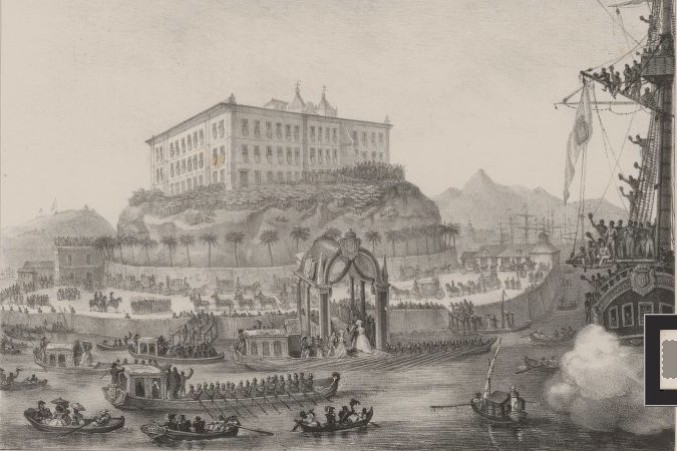
"Débarquement de la Princesse Léopoldine à Rio de Janiero" - 1839
©John Carter Brown Library, Archive of Early American Images ID: 9130003
What does this illustration say about the Brazilian monarchy? How is the princess welcomed to Brazil? How is the scene conveyed? How does the illustration reflect both European and Brazilian values in terms of its setting, its people, and its architecture?

"Acclamation du Roi Dom Jean VI à Rio de Janiero" - 1839
©John Carter Brown Library, Archive of Early American Images ID: 9140003
How does this image compare stylistically to Jacques Louis David’s “Consecration of the Emperor Napoleon I and Coronation of the Empress Josephine” from 1807? What does this comparison perhaps say about Debret’s opinion of Dom João VI?
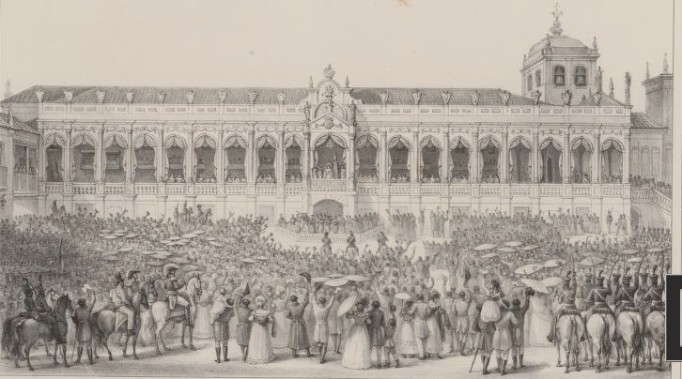
"Vue de L’Extérieur de la Galerie de l’Acclamation du Roi…" - 1839
©John Carter Brown Library, Archive of Early American Images ID: 9140004
What are the political implications of this lithograph? Which members of society are present at this ceremony? What does it say about the popularity of João VI? Is this a historically accurate illustration? Why or why not?
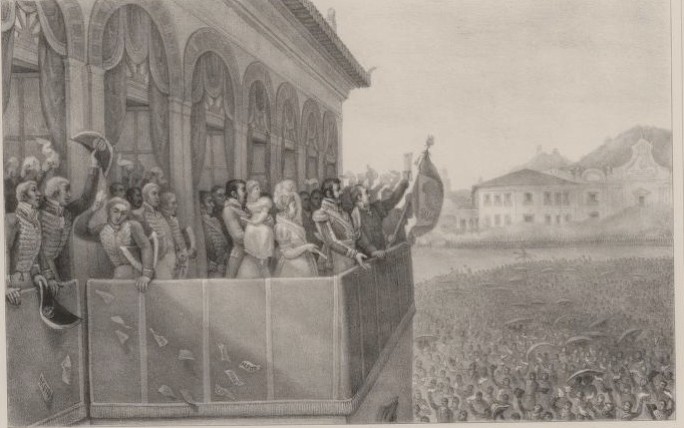
"Acclamation de Don Pédro 1er. Empereur du Brésil au camp de…" - 1839
©John Carter Brown Library, Archive of Early American Images ID: 9170001
What does this image say about the public’s enthusiasm for a new political system, led by Emperor Pedro I? How is Pedro I heralded as a national hero in this illustration?
[top left] "Le Rio Don João VI" [top right] "L’Empereur…" - 1839 ©John Carter Brown Library, Archive of Early American Images ID: 9030004 What does the difference in attire of these two men reflect about their political positions? What is the value in expressing them side by side? What are the similarities and differences between them? | 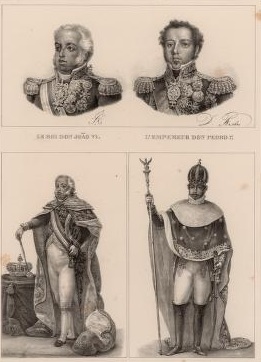 |
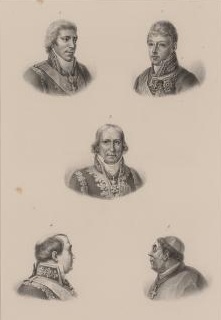 | "Ministres et Senateur" - 1839 ©John Carter Brown Library, Archive of Early American Images ID: 9150002 What was the role of a Brazilian minister? How did this role change over time? What do these portraits express about their personalities and positions? |
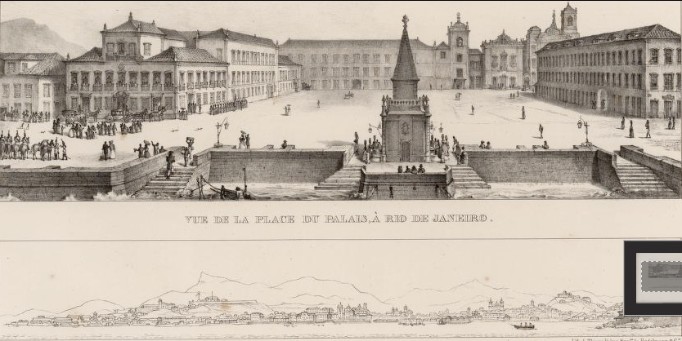
"[top] Vue de la Place de Palais, à Rio de Janiero [bottom] Vue Générale de la Ville, de Côté de la Mer" - 1839
©John Carter Brown Library, Archive of Early American Images ID: 9020003
Why did Debret show these two images together? How does one complement the other? What kinds of people are shown in ‘La Place de Palais’? What assumptions can be made about the economy and social structure of Rio de Janiero from this image?
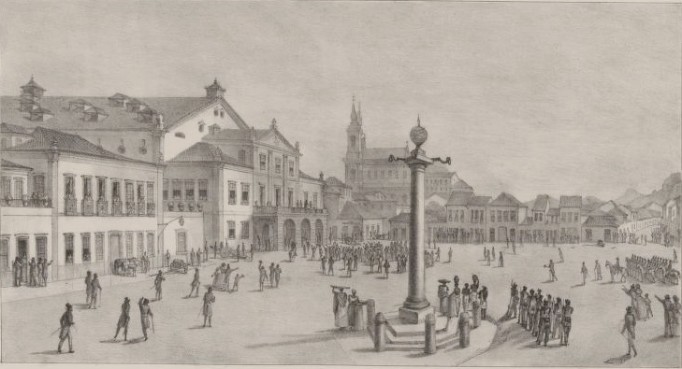
"Acceptation Provisoire de la Constitution de Lisbonne à Rio de Janiero en 1821" - 1839
©John Carter Brown Library, Archive of Early American Images ID: 9160003
How does the plaza depicted in this image differ from the one shown in Debret’s ‘Vue de la Place de Palais, à Rio de Janiero’? What kinds of people are shown and what kinds of tasks are they doing? How does the architecture differ from that of the aforementioned image?